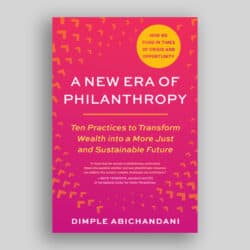Author Ian Murray tackles the issues related to accumulation comprehensively and astutely, offering legal and policy reforms that would allow intergenerational justice to play a more central role in decisions on how and when philanthropic assets are used.
Charity Law and Accumulation: Maintaining an Intergenerational Balance, by Ian Murray. Cambridge University Press; 2021; 281 pages; ISBN 9781108490597.
Charity Law and Accumulation is an exceptionally good book. And – given the current federal government consultation on the disbursement quota requirement for Canadian registered charities under the Income Tax Act – it is an exceptionally timely one that will be of particular interest to policy-makers and various charity decision-makers. The text originated as Ian Murray’s PhD thesis; in it, Murray, now an associate professor at the University of Western Australia, canvasses a little-explored area of charity law.
From its birth as a legal concept, there was a recognition that charity, manifest in its earliest form as trusts with charitable purposes, ought to be afforded certain legal and tax concessions. This led, centuries ago, to the ability to establish a pool of capital (what we now commonly call an endowment) and use all or part of the income from that fund, rather than the fund itself, to underwrite publicly beneficial work. The tension between holding back income to augment an endowment or retaining assets for later use and expending income (or capital) in the short-term has thus been an enduring feature of charity law. It has been complicated over time by the advent of charitable corporations and by the evolution of tax concessions for charities and their donors.
The issue has been brought into renewed focus by contemporary interest in “intergenerational justice.” (And, perhaps more broadly, by current concern over the distribution of resources between capital and income, the growth profile of those two categories of wealth, and the associated consequences for economic inequality.)
Murray situates the problem of accumulation in a broad societal and sector context, arguing that clarity and effectiveness are needed for rules in this area of charity law.
Murray tackles the issues related to accumulation comprehensively and with astute analysis and offers legal and policy reforms that would allow intergenerational justice to play a more central role in decisions on how philanthropic assets are deployed.
He begins by situating the problem of accumulation in a broad societal and sector context, arguing that clarity and effectiveness are needed for rules in this area of charity law. This is both to maintain trust and confidence in the sector and to ensure appropriate ethical, economic, and political considerations when striking the balance between resource accumulation and use. Murray draws a helpful distinction between holding on to assets as operational reserves (good, even vital, practice if charity resources are held in a corporation, rather than a trust) and augmentation of the organization’s capital resources.
Murray then deals with evidence of accumulation and the rationale for accumulation. He finds no systematic accumulation across jurisdictions and subsectors but does identify pockets of significant resource growth for certain types of charities. This, he argues, justifies looking at three concerns: possible delay of benefits until later generations, the appropriate decision-makers for deciding the timing of benefits, and enhanced administrative costs associated with accumulation.
The next section of Charity Law and Accumulation delves into the various existing mechanisms for dealing with accumulation. Murray analyzes four areas of law across numerous jurisdictions (countries, and states and provinces within countries). These include statutory and common law restraints on accumulation, the duties of charity fiduciaries that may come into play in accumulation decisions, administrative and cy-près schemes (court proceedings that have historically been used to alter aspects of a charitable body’s mandate or operations), and tax provisions.
He finds a patchwork of measures and outcomes but some promising tools for constraining or guiding accumulation decisions. That said, while Murray does an excellent job of extrapolating from the existing law, and even though he looks across multiple jurisdictions, there is limited material directly speaking to accumulation issues.
Murray addresses the issue of whether the accumulation purpose can be so broad as to preclude charitable status in the first place (because there is no public benefit provided until the funds are being used for charitable work). He also looks at the question of scope of the authority of charity trustees to deal with resources generated over time and added to the assets pool as opposed to forming part of the initial trust. He reviews director and trustee duties (which he dubs “controller duties”) to determine where they may be relevant to accumulation decisions.
Murray calls for statutory recognition of an obligation on charity trustees to consider intergenerational justice in their decision-making.
He then turns to the alternative control mechanisms, such as administrative and cy-près schemes, and looks at how they can be used in the context of influencing accumulation practices. Generally, however, there are well-established boundaries around these procedures, limiting the circumstances in which they can be used.
Tax provisions, which vary considerably by jurisdiction, pose their own difficulties. While requiring a nominal annual distribution is routine for many tax authorities, intervening on other than rudimentary charity law matters is often beyond their scope. An interesting nuance of this theme, which is not explored by Murray, is using the timing of tax concessions to donors or to the charity itself to influence accumulation practice. Currently, tax concessions are typically tied to receipt of an asset by the charity, not to when it is used for charitable work.
The concluding section of Charity Law and Accumulation deals with reform initiatives. A preliminary discussion introduces the concept of intergenerational justice and some of the challenges of embedding it in decision-making. Murray comes down against imposing a particular methodology on charities, preferring to have charity trustees adopt their own processes so long as they reflect the goal of taking intergenerational considerations into account. This echoes the deference courts historically have shown to other governance decisions – a focus on the integrity of the process, rather than on whether the eventual result was correct.
Murray favours strengthening a number of the existing mechanisms that could have an impact on accumulation decisions. Most particularly, however, he calls for statutory recognition of an obligation on charity trustees to consider intergenerational justice in their decision-making. This would be buttressed by increased reporting requirements. Murray argues this could be implemented without excessive extra costs on charities and is the best option to foster the continued independence of charities and charity decision-makers.
As Canadian regulators grapple with changes to the Income Tax Act disbursement quota regime, they might give some thought to the merit in Murray’s suggestion that the issue be refocused on charity governors and how best to prompt them to make decisions that better balance the needs of today and tomorrow. Sector recommendations made through the current consultation process have varied widely, and a key virtue of Murray’s approach is that it allows for the circumstances of individual charities to inform spending decisions.


